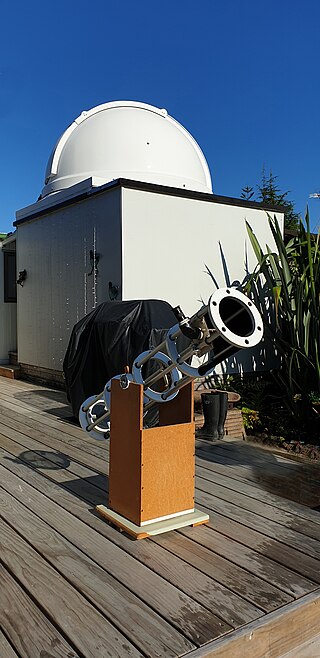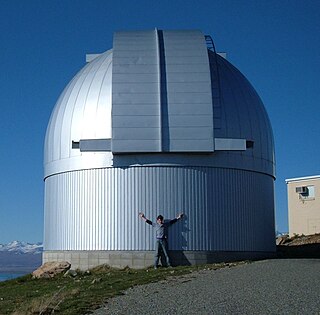Related Research Articles

A gravitational lens is a distribution of matter or a point particle between a distant light source and an observer that is capable of bending the light from the source as the light travels toward the observer. This effect is known as gravitational lensing, and the amount of bending is one of the predictions of Albert Einstein's general theory of relativity. Treating light as corpuscles travelling at the speed of light, Newtonian physics also predicts the bending of light, but only half of that predicted by general relativity.

The Spitzer Space Telescope, formerly the Space Infrared Telescope Facility (SIRTF), was an infrared space telescope launched in 2003. Operations ended on 30 January 2020. Spitzer was the third space telescope dedicated to infrared astronomy, following IRAS (1983) and ISO (1995–1998). It was the first spacecraft to use an Earth-trailing orbit, later used by the Kepler planet-finder.

A rogue planet is an interstellar object of planetary mass which is not gravitationally bound to any star or brown dwarf. Rogue planets may originate from planetary systems in which they are formed and later ejected, or they can also form on their own, outside a planetary system. The Milky Way alone may have billions to trillions of rogue planets, a range the upcoming Nancy Grace Roman Space Telescope will likely be able to narrow down.

Gravitational microlensing is an astronomical phenomenon due to the gravitational lens effect. It can be used to detect objects that range from the mass of a planet to the mass of a star, regardless of the light they emit. Typically, astronomers can only detect bright objects that emit much light (stars) or large objects that block background light. These objects make up only a minor portion of the mass of a galaxy. Microlensing allows the study of objects that emit little or no light. Gravitational microlensing was first theorised by Refstal (1964) and first discovered by Irwin et al (1988). The first object in the sky where it was discovered was the Einstein cross or Huchra lens 2237 +0305. The initial lightcurve of the object was published by Corrigan et al (1991). In Corrigan et al (1991) they calculated that the object causing the microlensing was a Jupiter sized object. This was the first discovery of a planet in another galaxy.

Farm Cove Observatory (FCO) is an amateur astronomical observatory in Pakuranga, Auckland, New Zealand, where Jennie McCormick discovered the main-belt asteroid 386622 New Zealand in September 2009.

OGLE-2005-BLG-390Lb is a super-Earth exoplanet orbiting OGLE-2005-BLG-390L, a star 21,500 ± 3,300 light-years from Earth near the center of the Milky Way, making it one of the most distant planets known. On January 25, 2006, Probing Lensing Anomalies NETwork/Robotic Telescope Network (PLANET/Robonet), Optical Gravitational Lensing Experiment (OGLE), and Microlensing Observations in Astrophysics (MOA) made a joint announcement of the discovery. The planet does not appear to meet conditions presumed necessary to support life.

OGLE-2005-BLG-390L is a star thought to be a spectral type M. This dim magnitude 16 galactic bulge star is located in the Scorpius constellation at a far distance of about 21,500 light years.

The Optical Gravitational Lensing Experiment (OGLE) is a Polish astronomical project based at the University of Warsaw that runs a long-term variability sky survey (1992–present). The main goals are the detection and classification of variable stars, discovery of microlensing events, dwarf novae, and studies of the structure of the Galaxy and the Magellanic Clouds. Since the project began in 1992, it has discovered a multitude of extrasolar planets, together with the first planet discovered using the transit method (OGLE-TR-56b) and gravitational microlensing. The project has been led by professor Andrzej Udalski since its inception.

Microlensing Observations in Astrophysics (MOA) is a collaborative project between researchers in New Zealand and Japan, led by Professor Yasushi Muraki of Nagoya University. They use microlensing to observe dark matter, extra-solar planets, and stellar atmospheres from the Southern Hemisphere. The group concentrates especially on the detection and observation of gravitational microlensing events of high magnification, of order 100 or more, as these provide the greatest sensitivity to extrasolar planets. They work with other groups in Australia, the United States and elsewhere. Observations are conducted at New Zealand's Mt. John University Observatory using a 1.8 m (70.9 in) reflector telescope built for the project.
OGLE-2003-BLG-235L (MOA-2003-BLG-53L) is a star in the constellation of Sagittarius. The first gravitational microlensing event for which a planet orbiting the lens was detected around this star. The event occurred in during July 2003. Two groups observed and independently detected the event: the Optical Gravitational Lensing Experiment (OGLE) and the Microlensing Observations in Astrophysics (MOA), hence, the double designation. It is an orange dwarf star of spectral type K, which is accompanied by a giant planet.
OGLE-2005-BLG-169L is a dim and distant magnitude 20 galactic bulge star located about 2,700 parsecs away in the constellation Sagittarius. If it is a main sequence star, then it is most likely a red dwarf with about half of the mass of the Sun. Other possibilities are a white dwarf star, or a neutron star or black hole.
OGLE-2005-BLG-071L is a distant, magnitude 19.5 galactic bulge star located in the constellation Scorpius, approximately 11,000 light years away from the Solar System. The star is probably a red dwarf with a mass 43% of that of the Sun.

OGLE-2006-BLG-109L is a dim magnitude 17 M0V galactic bulge star approximately 4,920 light-years away in the constellation of Scorpius.
The Microlensing Follow-Up Network is an informal group of observers who monitor high magnification gravitational microlensing events in the Milky Way's Galactic Bulge. Its goal is to detect extrasolar planets via microlensing of the parent star by the planet. μFUN is a follow-up network - they monitor microlensing events identified by survey groups such as OGLE and Microlensing Observations in Astrophysics (MOA).
In astronomy, the MACHO Project was an observational search during 1992-1999 for dark matter around our Milky Way galaxy in the form of hypothetical Massive Compact Halo Objects (MACHOs), using the method of gravitational microlensing. It was one of three first-generation microlensing searches started in the early 1990s, the others being the independent EROS and OGLE projects. The MACHO project was carried out by a team of US and Australian astronomers; observations used the 1.27-metre (50-inch) telescope at the Mount Stromlo Observatory near Canberra, which was dedicated to the project full-time from 1992 until 1999. The project did not solve the dark matter problem, but placed important upper limits on the fraction of dark matter in MACHOs across a wide range of masses, and achieved several notable discoveries in the field of microlensing, and new results on several classes of variable stars.
OGLE-2014-BLG-0124Lb is one of the farthest known planets in the universe. It is approximately 13,000 light years away, located near the center of the galaxy. The planet was discovered using a technique called microlensing. In this case it took 150 days. Two telescopes are used to detect the planet and the time difference between identification by each telescope is used to calculate the distance to the planet. This also contributes to determining the mass of the planet which is about half of Jupiter's. The planet orbits a star with a mass of 0.7 solar masses and is 3.1 AUs from it.

OGLE-2016-BLG-1195Lb is an extrasolar planet located about 22,000 light-years from Earth, in the galactic bulge, orbiting the 0.57±0.06M☉ star OGLE-2016-BLG-1195L, discovered in 2017. The planet was detected using gravitational microlensing techniques managed by the Korea Astronomy and Space Science Institute and the Spitzer Space Telescope. Initially, it was believed the planet has a mass similar to Earth and is located about the same distance from its host star as the Earth is from the Sun, although it was expected to be much colder.
OGLE-2018-BLG-0799Lb is a sub-Saturn-mass exoplanet discovered by the Optical Gravitational Lensing Experiment (OGLE) collaboration, through a gravitational microlensing event that occurred in May 2018. The discovery was announced in October 2020, and published in August 2022.

A rogue black hole is an interstellar object without a host galactic group. They are caused by collisions between two galaxies or when the merging of two black holes is disrupted. It has been estimated that there could be 12 rogue black holes in the Milky Way galaxy.
References
- 1 2 3 4 5 6 7 8 9 10 Ryu, Y.-H.; et al. (27 October 2017). "OGLE-2016-BLG-1190Lb: The FirstSpitzer Bulge Planet Lies Near the Planet/Brown-dwarf Boundary". The Astronomical Journal. 155: 40. arXiv: 1710.09974 . doi: 10.3847/1538-3881/aa9be4 . S2CID 54706921.
- 1 2 3 4 5 Staff (2017). "Planet OGLE-2016-BLG-1190L b". Extrasolar Planets Encyclopaedia . Retrieved 10 November 2017.
- 1 2 Nowakowski, Tomasz (6 November 2017). "Extremely massive exoplanet discovered in the Milky Way's bulge". Phys.org . Retrieved 10 November 2017.
- ↑ Bartels, Meghan (7 November 2017). "A Giant Exoplanet Is Hiding At The Center of the Milky Way Galaxy". Newsweek . Retrieved 10 November 2017.
- ↑ Wehner, Mike (7 November 2017). "Astronomers just spotted a planet so huge they aren't even sure it's really a planet". BGR . Retrieved 10 November 2017.



